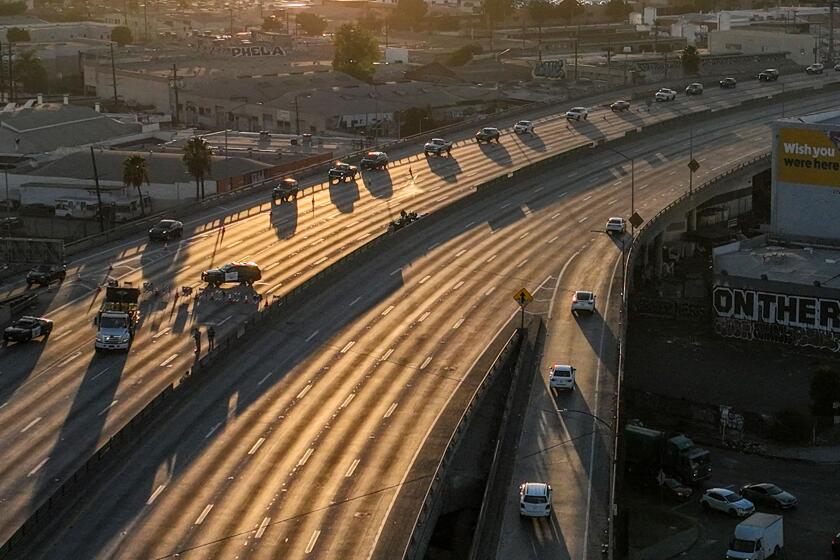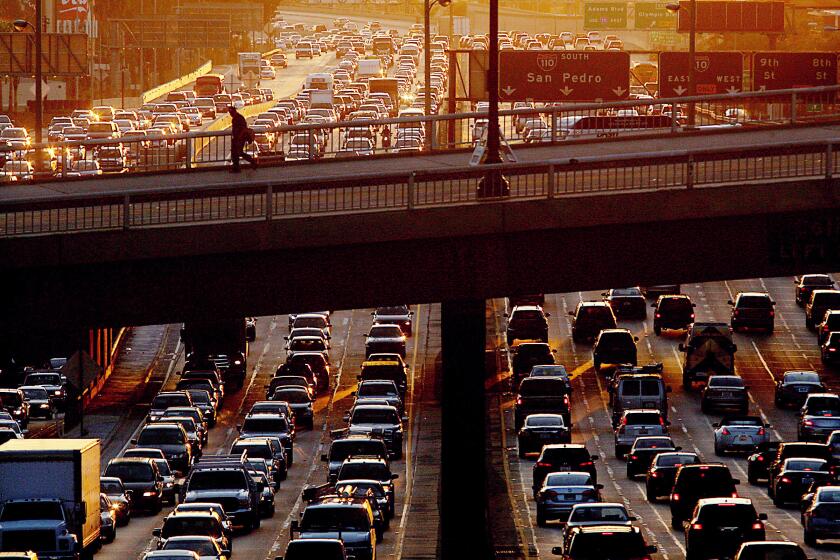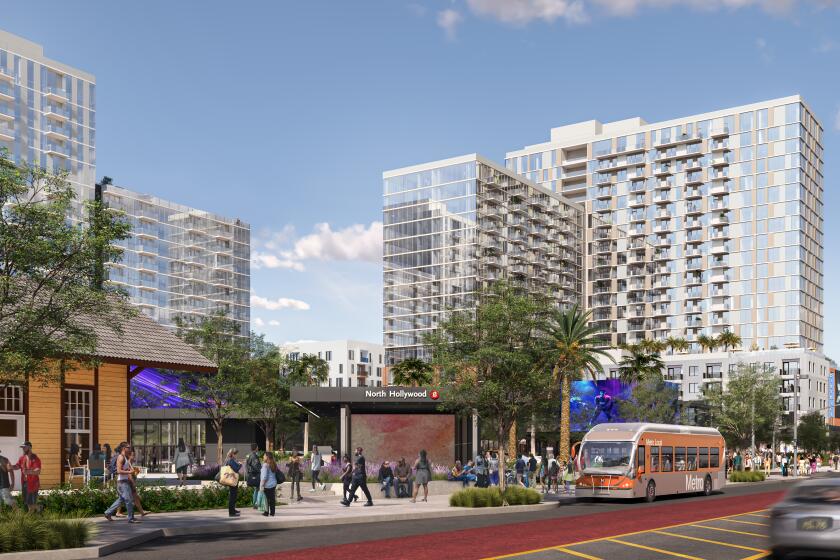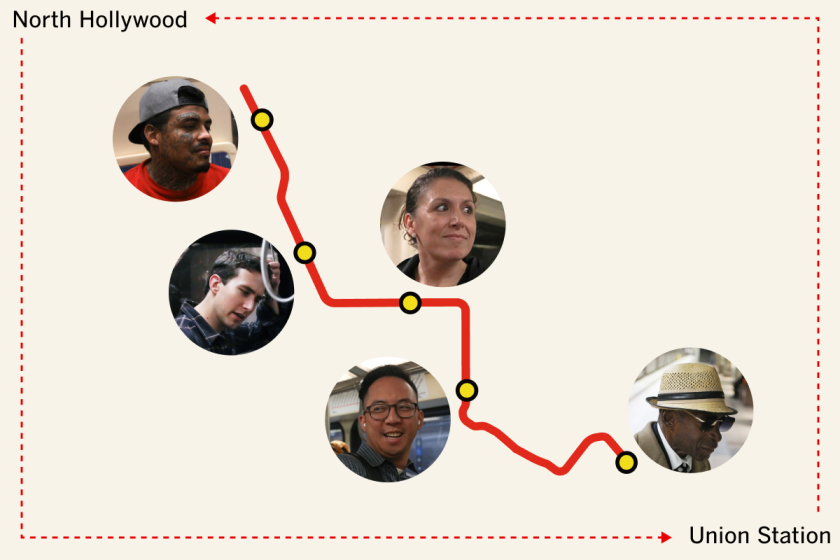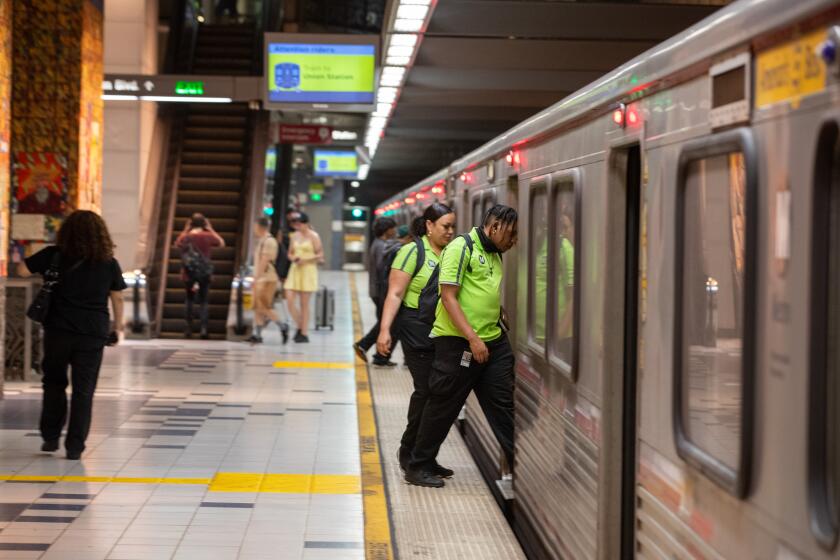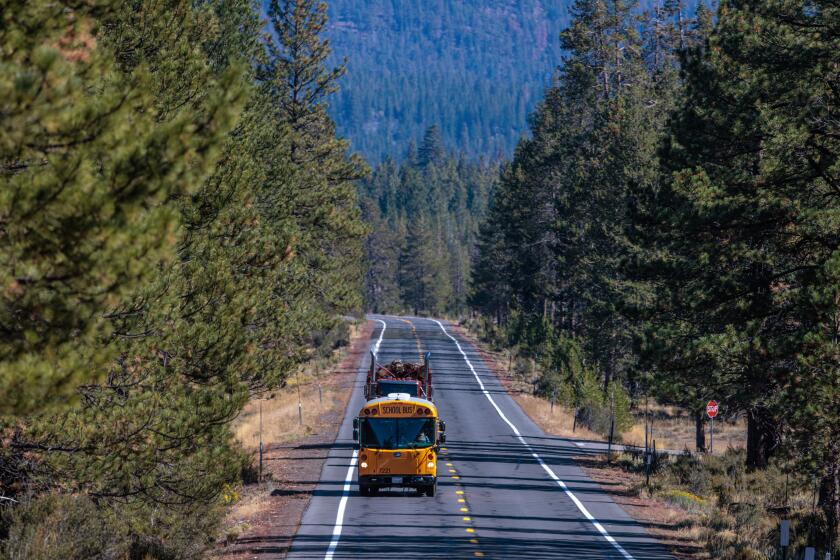Mammoth $2-billion 405 project marks an end to Southland’s big freeway era

The opening of new express lanes on the 405 Freeway in northwest Orange County on Friday marked the final step of a massive $2.16-billion highway improvement project.
But in many ways, it also wrapped up one of the region’s last major freeway expansions as transportation officials move toward more sustainable and efficient investments.
“The era of the big highway projects are over,” said Marlon Boarnet, an urban planning professor at USC and the director of the METRANS Transportation Consortium. “The big, big highway projects are going to become more rare. ... [Future work] is going to become much more part of a more balanced system.”
It’s not that Southern California isn’t expected to continue to grow. But transportation leaders are at a crucial juncture, facing limited space for roadways and lofty green energy goals, which together are forcing future projects to become less car-centric.
“There’s certainly still some freeway projects, but nothing like the scale of this last major freeway project,” Eric Carpenter, a spokesperson for the Orange County Transportation Authority, said of the I-405 Improvement Project.
The mammoth project, funded heavily through a voter-approved tax, initially broke ground in January 2018 but is now getting its finishing touches, such as lighting and paint, Carpenter said.
During the almost six years of construction, crews widened the 16-mile stretch between Costa Mesa and the southern Los Angeles County line by one lane in each direction, and also added the four toll-funded express lanes, all aimed at easing congestion on one of the nation’s busiest corridors, according to the Orange County Transportation Authority.
The damaged 10 Freeway through downtown L.A. will be reopened much faster than initially thought. It’s been a ‘crazy push to get this bridge open,”’ an engineer says.
The new express lanes, which run both directions between the 73 and 605 freeways, can be accessed for free by some carpoolers or require a variable toll for other drivers, depending on distance and travel time.
Carpenter said there are still some ongoing and future highway projects and improvements in Orange County, but none are as massive as this one on the 405 Freeway.
“We’re simply out of room,” Carpenter said. “As Orange County gets bigger, we’re committed to that idea of a balanced, sustainable future.”
He said that means spending more time and money on mass transit projects or ones that include bike lanes, railways and even modern streetcars, as is underway in Santa Ana.
Boarnet said he expects to see transportation officials continue their shift from from building and expanding freeways to multi-modal systems and what he called “demand control” measures, such as toll roads.
He said this redirected focus can better build the region’s “balanced portfolio,” which helps minimize the need for unused land in a crowded metropolis, reduce commuters’ carbon footprints and ease traffic — as well as bring in new public funds as electric cars become more prevalent.
Drivers on the 405 Freeway in O.C. could pay $10 tolls, get extra lanes. Would it help with traffic?
Commuters on the 405 Freeway in Orange County could soon be driving in new lanes and paying tolls of nearly $10 to use the express lanes during peak hours.
“We’re well down the path of the gas tax no longer working as a revenue instrument,” Boarnet said.
This transportation shift is happening not just in Orange County but also across the Southland and the state.
Los Angeles County has been investing heavily in a growing rail system, with the K Line and a new downtown L.A. railway line opening this year and other lines in the works. A people mover system for Los Angeles International Airport is expected to open next year.
There have also been some quixotic proposals in recent years to close L.A. freeways. Recently, activists pushed to turn the Marina Freeway into a park and housing, and there was an earlier trial balloon to shut the small Terminal Island Freeway.
Even though Caltrans has become synonymous with freeway building, the agency has been trying to reshape itself as it grapples with that legacy and new emission goals.
“Over the last few decades, Caltrans has shifted from a highway-building department to a truly public transportation department,” Allison Colburn, a Caltrans District 7 spokesperson, said in a statement Friday. The agency is actively engaged in projects focused on adding bus and bike lanes to roadways, while still rehabilitating certain streets and bridges.
California Transportation Secretary Toks Omishakin told The Times last year the state will no longer add freeway lanes solely to allow more cars and trucks to use them. That’s because studies have shown that building more freeway lanes may ease congestion in the short term, but in the long-run it actually stokes more demand.
That mandate, climate goals and pressure from advocates have transportation planners in Los Angeles turning to traffic management on freeways via carpool lanes and fees. The Los Angeles County Metropolitan Transportation Authority is now weighing a congestion pricing plan that aims to lessen traffic on freeways by charging people during peak hours.
Among the locations it’s looking to add congestion pricing is on roads connecting the San Fernando Valley to Los Angeles, including through the Sepulveda Pass, where a $1.6-billion freeway expansion completed in 2015 did little to eliminate the choking traffic years later.
But Metro’s Shahrzad Amiri, deputy chief of operations for congestion reduction programs, said slowly implementing these express lanes across the region has helped change the public perception of such tolls as people realize their time savings.
“Initially there was a lot of opposition to tolling, express lanes-style, and that has changed,” Amiri said, noting that expanding those lanes has also allowed Metro to reinvest those funds in other modes of non-highway transportation.
Motorists already in possession of a transponder will avoid an additional fee that will cover the costs of the new program.
On northwest Orange County’s new express lanes, cars are required to use a FasTrak transponder, which can be purchased online. Toll pricing varies by hour, day of the week and distance traveled, and the costs are adjusted regularly “to ensure a free-flowing commute,” said Megan Abba, an OCTA spokesperson.
The express lanes will be free for vehicles with two or more occupants during non-peak hours, while vehicles with three or more inside can always use the tolled lanes for free, Abba said. Motorcycles and vehicles with veterans or disabled license plates also can always drive without tolls, Abba said. Peak hours are from 6 to 10 a.m. and 2 to 7 p.m. weekdays, and on weekends 1 to 7 p.m.
On average, tolls will cost drivers $3 to travel the entire stretch of the express lanes, but solo drivers could pay as much as $9.95 during certain peak hours, Abba said.
The busy stretch of the 405 that was recently widened sees, on average, 370,000 vehicles a day, according to transportation officials. The major project also improved onramps and offramps and reconstructed 18 bridges, many that now include sidewalks and bike lanes, OCTA officials said.
Carpenter said it was great to finally see the construction provide travelers with real-time benefits Friday. “There’s a lot of excitement about it,” he said.
Start your day right
Sign up for Essential California for news, features and recommendations from the L.A. Times and beyond in your inbox six days a week.
You may occasionally receive promotional content from the Los Angeles Times.
